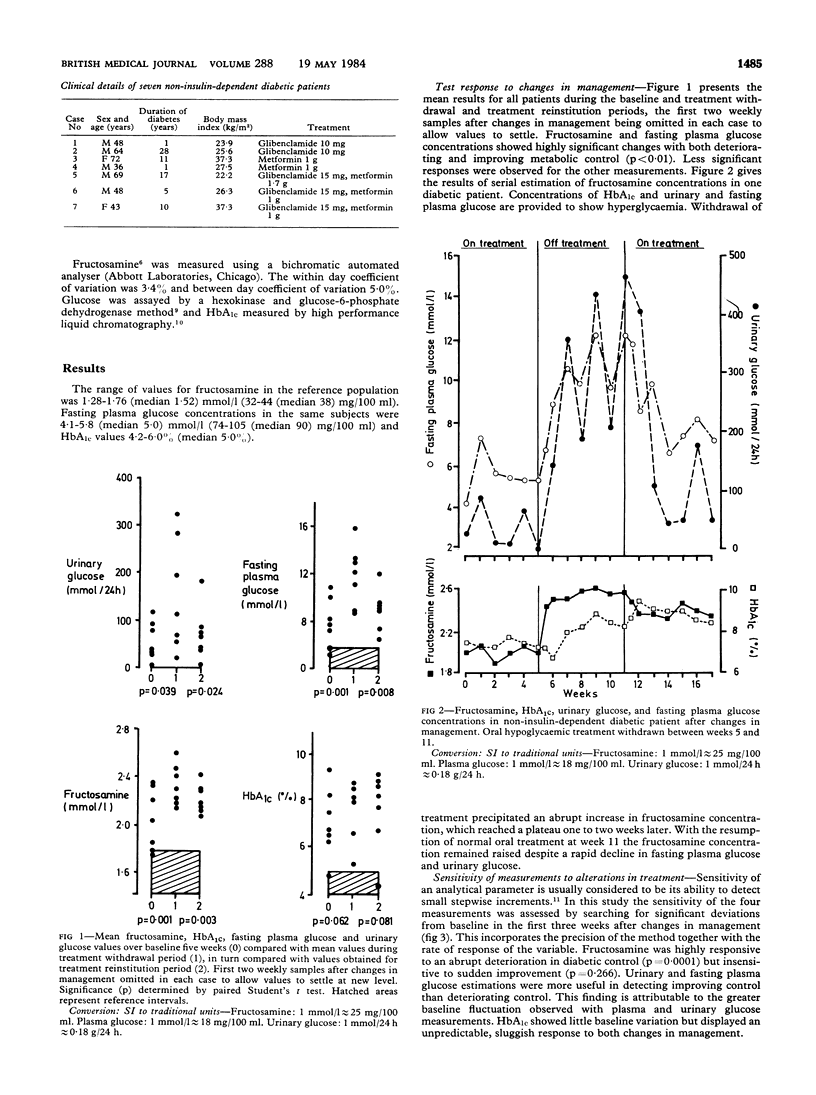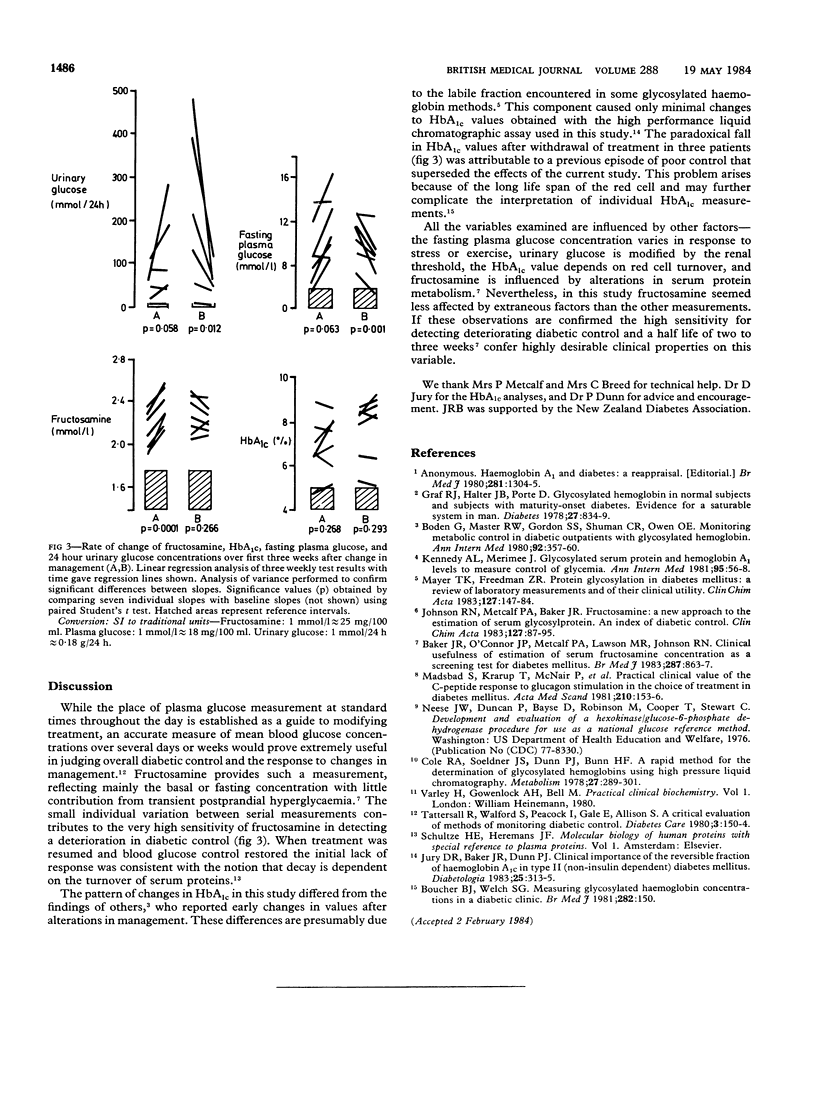Abstract
The serum fructosamine concentration was examined as a new means to monitor metabolic control in non-insulin-dependent diabetes during changes in management. Weekly fructosamine estimations were compared with glycosylated haemoglobin (HbA1c), 24 hour urinary glucose, and fasting plasma glucose concentrations in a 17 week study entailing withdrawal and reinstitution of oral treatment. The serum fructosamine concentration was more sensitive than the other measurements in detecting a deterioration in diabetic control after stopping oral hypoglycaemic drugs. The response to reinstitution of treatment was not significant in the first three weeks (p = 0.266), despite a highly significant reduction in fasting plasma glucose (p = 0.001) and 24 hour urinary glucose concentrations (p = 0.012). Compared with HbA1c, concentrations of fructosamine appeared more useful in monitoring short term (three to six weeks) changes after alterations in management of diabetes. Additional advantages were lower cost and technical simplicity of measurement.
Full text
PDF


Selected References
These references are in PubMed. This may not be the complete list of references from this article.
- Baker J. R., O'Connor J. P., Metcalf P. A., Lawson M. R., Johnson R. N. Clinical usefulness of estimation of serum fructosamine concentration as a screening test for diabetes mellitus. Br Med J (Clin Res Ed) 1983 Sep 24;287(6396):863–867. doi: 10.1136/bmj.287.6396.863. [DOI] [PMC free article] [PubMed] [Google Scholar]
- Boden G., Master R. W., Gordon S. S., Shuman C. R., Owen O. E. Monitoring metabolic control in diabetic outpatients with glycosylated hemoglobin. Ann Intern Med. 1980 Mar;92(3):357–360. doi: 10.7326/0003-4819-92-3-357. [DOI] [PubMed] [Google Scholar]
- Boucher B. J., Welch S. G. Measuring glycosylated haemoglobin concentrations in a diabetic clinic. Br Med J (Clin Res Ed) 1981 Jan 10;282(6258):150–150. doi: 10.1136/bmj.282.6258.150. [DOI] [PMC free article] [PubMed] [Google Scholar]
- Cole R. A., Soeldner J. S., Dunn P. J., Bunn H. F. A rapid method for the determination of glycosylated hemoglobins using high pressure liquid chromatography. Metabolism. 1978 Mar;27(3):289–301. doi: 10.1016/0026-0495(78)90109-9. [DOI] [PubMed] [Google Scholar]
- Graf R. J., Halter J. B., Porte D., Jr Glycosylated hemoglobin in normal subjects and subjects with maturity-onset diabetes. Evidence for a saturable system in man. Diabetes. 1978 Aug;27(8):834–839. doi: 10.2337/diab.27.8.834. [DOI] [PubMed] [Google Scholar]
- Johnson R. N., Metcalf P. A., Baker J. R. Fructosamine: a new approach to the estimation of serum glycosylprotein. An index of diabetic control. Clin Chim Acta. 1983 Jan 7;127(1):87–95. doi: 10.1016/0009-8981(83)90078-5. [DOI] [PubMed] [Google Scholar]
- Jury D. R., Baker J. R., Dunn P. J. Clinical importance of the reversible fraction of haemoglobin A1c in Type 2 (non-insulin-dependent) diabetes. Diabetologia. 1983 Oct;25(4):313–315. doi: 10.1007/BF00253192. [DOI] [PubMed] [Google Scholar]
- Kennedy A. L., Merimee T. J. Glycosylated serum protein and hemoglobin A1 levels to measure control of glycemia. Ann Intern Med. 1981 Jul;95(1):56–58. doi: 10.7326/0003-4819-95-1-56. [DOI] [PubMed] [Google Scholar]
- Madsbad S., Krarup T., McNair P., Christiansen C., Faber O. K., Transbøl I., Binder C. Practical clinical value of the C-peptide response to glucagon stimulation in the choice of treatment in diabetes mellitus. Acta Med Scand. 1981;210(3):153–156. doi: 10.1111/j.0954-6820.1981.tb09793.x. [DOI] [PubMed] [Google Scholar]
- Mayer T. K., Freedman Z. R. Protein glycosylation in diabetes mellitus: a review of laboratory measurements and of their clinical utility. Clin Chim Acta. 1983 Jan 24;127(2):147–184. doi: 10.1016/s0009-8981(83)80002-3. [DOI] [PubMed] [Google Scholar]
- Tattersall R., Walford S., Peacock I., Gale E., Allison S. A critical evaluation of methods of monitoring diabetic control. Diabetes Care. 1980 Jan-Feb;3(1):150–154. doi: 10.2337/diacare.3.1.150. [DOI] [PubMed] [Google Scholar]


